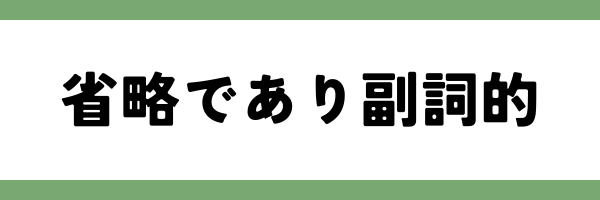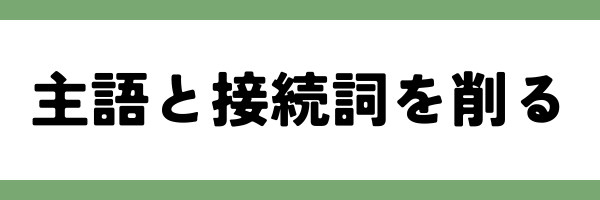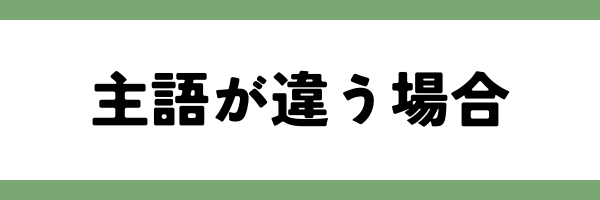こんにちは。せいじです。(@seiz_suzuki)
- 分詞構文とは何か?
- 分詞構文の作り方
- 長文や会話で出てくる表現
分詞構文とは?

分詞構文とは、いったい何なのでしょうか。

- When I walked along the street, I found a ten-dollar bill.
- Walking along the street, I found a ten-dollar bill.(通りを歩いていると、10ドル札を見つけた)
そして分詞構文が「〜ingの副詞的な用法」と言われるゆえんは、まさに副詞節(=副詞的に使うカンマを伴う文のこと)を変化させたものだからです😊
- 分詞構文とは〜ingや〜edを使った省略
- 「〜ing」を使うことがあるため副詞的用法だと言われることも
- もともとある副詞節を短くするため、副詞的な用法として見なされる
分詞構文の作り方
 分詞構文は難しいと言われがちですが、実は作り方はいたってシンプルです😊
分詞構文は難しいと言われがちですが、実は作り方はいたってシンプルです😊
早速見ていきましょう♪
- 副詞節を見る
- 接続詞を省略する
- 主語が一致している場合、主語を省略する
- 残っている動詞を〜ingにする
- After he finished his homework, he went out to play.
Afterhe finished his homework, he went out to play.hefinished his homework, he went out to play.- finish
edhis homework, he went out to play. - Finishing his homework, he went out to play.(宿題を終えると、彼は遊びに出かけた)
受け身・完了・否定
実は別の形のように見えるものでも、しっかりとやり方に沿っていけば大丈夫です✨
一つずつトライしていきましょう♪
【副詞節の中が受け身】
- Because it was written in simple English, the book was easy to understand.
Becauseit was written in simple English, the book was easy to understand.itwas written in simple English, the book was easy to understand.waswritten in simple English, the book was easy to understand.- Being written in simple English, the book was easy to understand.(簡単な英語で書かれていたので、その本は理解しやすかった)
ただし、
- Being tired, I went to bed early.(疲れていたので、早く寝た)
- Being rich, she was not happy.(裕福だが、彼女は幸せではなかった)
といったような文のように、形容詞だけをおいてカンマ(「Tired, I went to…」)のような一語だけの書き方はできません💦
次に完了形の場合を見てみましょう♪
【副詞節の中が完了形】
- After I had finished my work, I went home.
AfterI had finished my work, I went home.Ihad finished my work, I went home.- ha
dfinished my work, I went home. - Having finished my work, I went home.(仕事を終えてから、家に帰った)
【副詞節の中が否定形】
- As she didn’t know what to do, she asked her teacher for advice.
Asshe didn’t know what to do, she asked her teacher for advice.shedidn’t know what to do, she asked her teacher for advice.didn’t know what to do, she asked her teacher for advice.- not know what to do, she asked her teacher for advice.
- Not knowing what to do, she asked her teacher for advice.(何をすべきか分からなかったので、彼女は先生に助言を求めた)
否定文の場合、付随している「do/does/did」などはそのまま消し去ります😊
文頭にNotがくる珍しい表現です✨
復元作業はどうする?
◎ Turning to the right, you will find the post office.
- ◎ If you turn to the right, you will find the post office.
- △ When you turn to the right, you will find the post office.
- △ After you turn to the right, you will find the post office.
独立分詞構文とは?

【主語がカンマの前後で異なる場合】
- As it was a fine day, we went on a picnic.
Asit was a fine day, we went on a picnic.- it was a fine day, we went on a picnic.
- It
wasa fine day, we went on a picnic. - It being a fine day, we went on a picnic.(いい天気だったので、私たちはピクニックに行った)
仮に「主語を残さなかった場合」を想定してみましょう👇
🙅♂️ Being a fine day, we went on a picnic.
この場合、なんと「カンマ前の副詞節の主語」がWeとなってしまいます!😱
「私たちが良い日だったので、ピクニックに出かけました」という、不思議な文になってしまうのです💦
独立分詞構文の慣用表現
特に「分詞」を使った慣用表現はたくさんあります♪
もはや「主語すらないもの」もありますので、覚えておきましょう🙌
- Strictly speaking, a whale is not a fish.(厳密に言えば、クジラは魚ではない)
- Generally speaking, Japanese people are polite.(一般的に言えば、日本人は礼儀正しい)
- Frankly speaking, I don’t agree with your opinion.(率直に言えば、私はあなたの意見に賛成しません)
- Judging from her expression, she is very happy.(彼女の表情から判断すると、彼女はとても幸せだ)
- Weather permitting, we will have a barbecue tomorrow.(天気が許せば、明日バーベキューをします)
- All things considered, it was a good decision.(全てを考慮すると、それは良い決断だった)
これらは高校英語(大学受験)では必須の知識です✨
まとめ
分詞構文のまとめです✨
- 分詞を用いた、単なる副詞節の省略
- 現在分詞や過去分詞、完了や否定もある
- 復元作業は勘(かん)に頼り自然な訳を目指す
- 主語が違う場合には注意。独立分詞構文は慣用表現まで暗記






